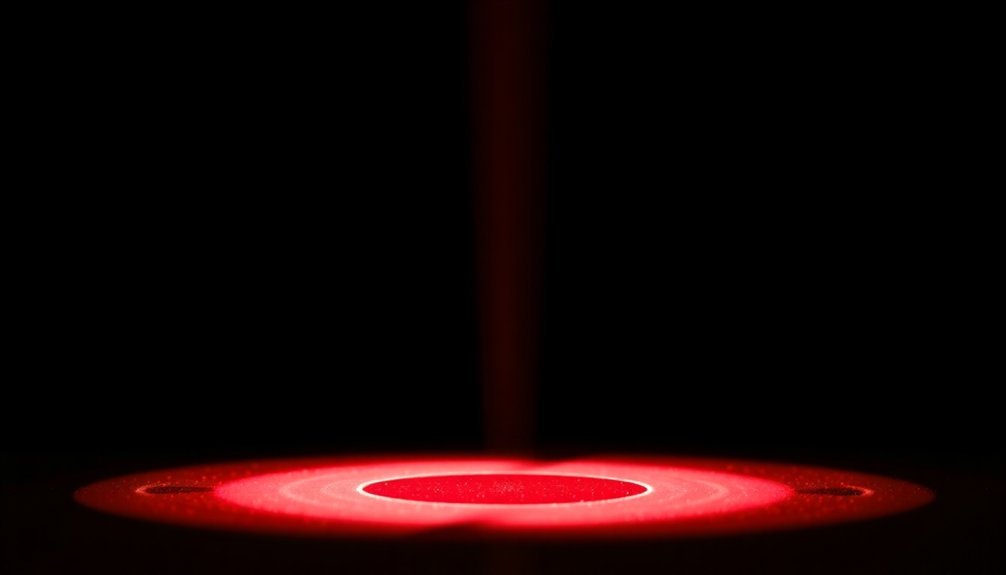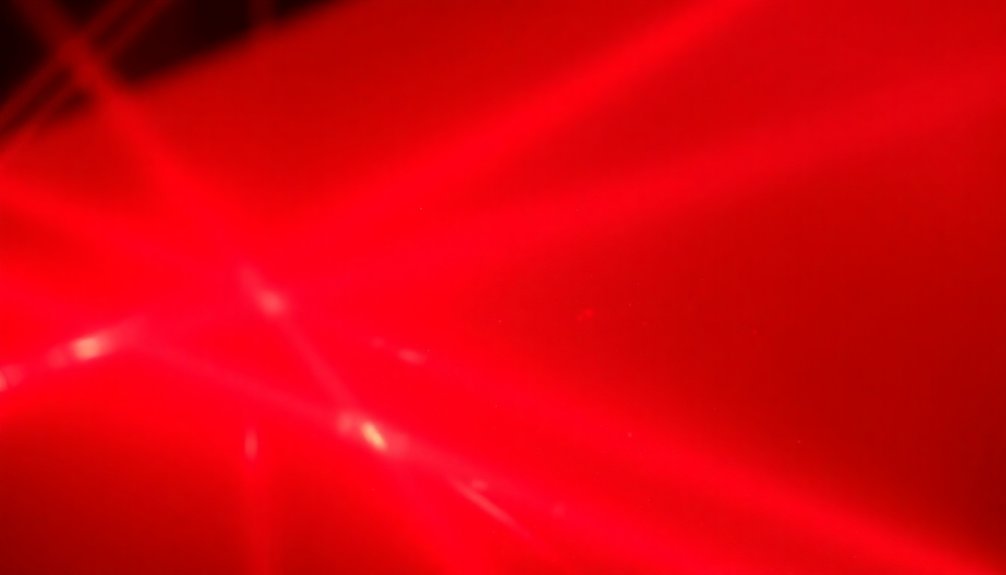The most effective wavelength combination for nerve recovery pairs 633nm, 830nm, and 660nm light therapy. You'll get the best results using 633nm for surface-level nerve regeneration and oxidative stress protection, while 830nm penetrates deeper to repair tissue damage up to 25mm below the surface. The 660nm wavelength works synergistically with both, enhancing ATP production and reducing inflammation at energy densities around 9 J/cm². This triple-wavelength approach activates multiple healing pathways, from stimulating Schwann cells to boosting mitochondrial function. Understanding how each wavelength contributes to healing can help you maximize your recovery outcomes.
The Power of 633nm Light

While various wavelengths of light therapy exist, 633nm red light stands out as a powerful tool for nerve regeneration and skin health. You'll find this specific wavelength particularly effective for facial nerve recovery, as it accelerates regeneration and improves functional outcomes.
It works by protecting geniculate ganglion neurons from oxidative stress-induced cell death and enhances the expression of Schwann cells, which are essential for nerve repair.
You can expect significant benefits when using 633nm light, especially for conditions involving the outer layers of your skin. The light penetrates about 8-10 millimeters deep, making it ideal for dermal and epidermal treatments. The treatment is safe and non-invasive, with no adverse side effects reported.
It's particularly effective at stimulating collagen synthesis, improving skin elasticity, and reducing inflammation – benefits you'll appreciate if you're dealing with acne or rosacea.
When compared to other wavelengths like 804nm, 730nm, or 980nm, 633nm light consistently shows superior results for nerve recovery. While it doesn't penetrate as deeply as NIR wavelengths, making it less suitable for deep tissue issues, it's your best choice for treating surface-level nerve damage and skin-related concerns.
830nm Wavelength Benefits
Exploring the near-infrared (NIR) spectrum reveals powerful healing properties, particularly in the 810-830nm range. You'll find these wavelengths offer exceptional penetration depth, reaching deep into your dermis and hypodermis layers for maximum therapeutic effect. Research demonstrates that delivering energy below 10J/cm² provides the most beneficial therapeutic outcomes.
| Feature | 810nm | 830nm |
|---|---|---|
| Penetration | Deep dermis & hypodermis | Deep dermis & hypodermis |
| Pain Management | Ideal (0.8-9J, 15-180s) | Strong effectiveness |
| Nerve Recovery | Promotes regeneration | Superior morphological repair |
| Blood Flow | Increases circulation | Enhanced NO release |
| Cellular Impact | Boosts mitochondrial function | Ideal muscle stimulation |
Both wavelengths excel at nerve regeneration, but they've got unique strengths. 810nm wavelengths are particularly effective for pain management and anti-inflammatory responses, while 830nm shows superior results in morphological nerve repair and muscle function. You'll benefit from either wavelength's ability to stimulate cellular energy production and improve blood circulation. For ideal nerve recovery, these wavelengths work by increasing antioxidation levels and promoting nitric oxide release, which enhances local blood flow and supports tissue healing. The scientific evidence strongly supports using either wavelength, with 830nm often receiving slightly higher recommendations due to its thorough therapeutic benefits.
660nm Therapeutic Effects

Light therapy's effectiveness differs substantially across different wavelengths, with both red light (600-700nm) and near-infrared (800-1000nm) ranges offering distinct therapeutic benefits for nerve recovery.
Red light at 630-660nm excels at promoting nerve regeneration, reducing neuropathic pain, and improving functional recovery, particularly at energy densities around 9 J/cm2. Early treatment with optimal recovery outcomes has shown the greatest success in facial nerve damage.
When you're targeting deeper tissues, near-infrared wavelengths like 810nm and 830nm penetrate up to 25mm below the surface, making them ideal for treating severe peripheral nerve injuries and deep tissue damage. They're particularly effective in accelerating functional recovery after autograft repairs and improving morphological nerve repair in facial nerves.
You'll achieve the best results by combining red and NIR wavelengths, as they work synergistically to address multiple aspects of nerve recovery. This dual approach activates cytochrome c oxidase, enhances ATP production, and stimulates light-sensitive ion channels.
For the best outcomes, you'll want to maintain energy densities between 6-6.2 J/cm2, as lower densities (3.2 J/cm2) haven't shown statistically significant improvements in nerve recovery studies.
Frequently Asked Questions
How Long Should Each Photobiomodulation Treatment Session Last for Nerve Recovery?
You'll want to plan for 4-minute sessions, though durations can vary from 28 seconds to 20 minutes. Most successful studies use 240-second treatments, but your specific needs may require adjustments based on wavelength and injury.
Can Multiple Wavelengths Be Used Simultaneously for Enhanced Nerve Regeneration?
Yes, you can use multiple wavelengths simultaneously for better nerve regeneration. It's proven to be more effective than single wavelengths, as different frequencies target various aspects of healing and stimulate different therapeutic responses.
What's the Minimum Treatment Frequency Needed to See Nerve Recovery Results?
You'll need at least 2-3 treatments per week for 6-8 weeks to see initial nerve recovery results. It's important that you maintain consistent sessions, as sporadic treatments won't provide ideal regenerative benefits.
Are There Any Side Effects From Long-Term Use of Light Therapy?
You'll typically experience mild side effects like headaches, sleep changes, and temporary skin irritation. While long-term use is generally safe, you should monitor any symptoms and consult your doctor if they're troublesome.
Does the Effectiveness Vary Based on the Depth of Nerve Damage?
Yes, your nerve damage depth directly affects treatment success. You'll need higher wavelengths (980nm) for deeper injuries, while superficial nerve damage responds well to lower wavelengths (810nm) during light therapy sessions.
In Summary
You'll find these three wavelengths – 633nm, 830nm, and 660nm – are your most effective options for nerve regeneration and healing. While each wavelength offers unique benefits, they work best when used together in your treatment protocol. Remember to consult your healthcare provider about incorporating these specific light therapies into your recovery plan for ideal nerve repair results.





Leave a Reply